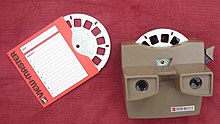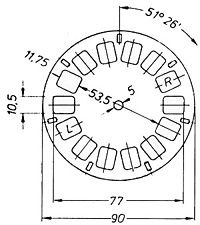View master
The View-Master is a viewing device for stereoscopic images that are applied as slides on a cardboard disc. There were similar slide viewers with the Tru-Vue system up until the 1950s and with the Stereomat in the GDR .
nature
Viewer
The View-Master has two peepholes with small lenses and is held directly in front of the eyes. European models are held in front of a light source (sun, lamp, daylight), American models are also available with their own lamp and batteries. A lever on the side of the viewer enables the user to switch to the next image on the pane. Today it is mainly marketed as a children's toy.
Discs
One disc contains seven stereo image pairs. Discs on offer show pictures of tourist destinations, from movies and TV series or they tell picture stories. There used to be medical textbooks too; the largest work, the Stereoscopic Atlas of Human Anatomy, contained 221 image slices with a total of 1554 color images of the human body. For several years now, companies have been offering private and corporate customers the tailor-made production of individual View Master panes with their own or commissioned images.
According to DIN 4531 , View Master discs are specified as "seven-part stereo discs with the dimensions of 10.5 × 11.75 mm per field". The standard also specifies the specifications of the nominal image sizes (= external sizes of the slides) 6 × 13 cm, 4 × 10 cm and 5 × 5 cm. In addition to the View Master discs, there is also another small size for a 10-part stereo card with 10 × 15 mm per field.
history
The View-Master was created around 1939 as an entertainment system for the home. At that time it represented an improvement on the common stereoscopes , in which a new photo card had to be inserted to view the next image. It was therefore more convenient to use. The thematic focus of the pictures were travel destinations and scientific documentation. Special stereo cameras and blank image discs were also available , with which you could take your own photos for the View-Master. The picture disks, which were initially sold individually, were combined into series with usually three disks from the early 1950s.
By 1961 there were 140 titles available. These included fairy tale, Walt Disney , animal, Europe travel, nations of the world, and world travel series. The pairs of images that were cut with our own editing machine could be inserted into blank panes specially offered. Blank discs have been offered again since around the 2010s.
In addition to the handheld devices such as the "G Standard", "F" and "D" models for viewing the images by one person, there were also special slide projectors , the "Junior", "Standard" and "De Luxe" models from Sawyer 'S were evicted. Simpler and therefore more cost-effective devices projected only one of the partial images, but did not allow a spatial impression . The projector with the model name “Stereomatic 500” was the only projection device that could also project 3D images onto the screen. To do this, the two images are encoded by polarizing filters . A silver screen (e.g. Reflecta "Superstar" or "Twinstar") and 3D glasses (linear polarizing filter, 45 ° / 135 ° rotated) are required for viewing . This system enabled several people to view the same image spatially at the same time. Institutes and universities occasionally used the projector in lectures, for which there were entire volumes with scientific image disks.
The Tru-Vue system that existed at the same time owned the rights to Walt Disney productions. When View-Master took over Tru-Vue in 1951, Walt Disney films could also be marketed, and the Tru-Vue system was discontinued. In the GDR , a similar system was called Stereomat.
In Czechoslovakia , the manufacturer Meopta produced several versions of the View-Master-like meoscope and matching stereo cameras in the 1960s to 1980s .
In the period from 1970 to 1981 the “Talking View Master” was also offered. On the back of each image disc was a small record that was mechanically scanned. A loudspeaker was attached below, from which the sound came to the pictures.
In 1966 View-Master was taken over by General Aniline & Film Corporation (GAF). Then the focus of the picture series changed to adaptations of well-known feature films, cartoons and comics. In 1981, View-Master was bought up again and renamed the View-Master International Group , which was taken over by Ideal Toys in 1984 and was now called the View-Master Ideal Group . In 1989, Tyco took over this company and merged with Mattel in 1997 , where the View-Master can now be found in the Fisher-Price toy range .
Since 2016, Mattel has been offering new, digital virtual reality glasses for children under the brand name View-Master , with which three-dimensional 360 ° videos can be viewed.
Own recordings
Special stereo cameras with two lenses were available for your own View Master recordings. From 1952 a camera under the name "View-Master Personal Stereo Camera" was marketed in the US by the company Sawyer's normal with the end user using 35mm - slide film could create your own stereo image pairs. In 1961, a revised camera model came onto the market in Europe as the “View-Master Stereo Color Camera”.

The two individual images were arranged at an angle and offset on the film strip and had to be punched out with a special punch. On the market you could buy empty cardboard View-Master disks into which the two fields were clamped or glued.
See also
Web links
- View-Master and other 3D viewer (english)
- World of stereoscopy
- View-Master devices and accessories (English)
- Speaking view masters (English)
Individual evidence
- ↑ http://www.explora.info/expo/expo08.php
- ↑ z. B. 3DWorldShop or Image3D , accessed August 30, 2013
- ↑ Reel Mounts on the Fresa Volante website , accessed on August 30, 2013 (English)



